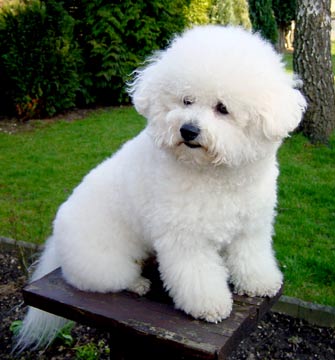
Bichon Frise

Navigate through the tabs
Navigate through the tabs below to view the breed's info of your interest.
The breed's info is divided in four sections; namely:
the breed's history ,
the breed's main stats ,
the dog's potential health issues
and finally, how the breed scored in 26 different categories.
All the above information should give you a respectively good overview for the dog of your interest.
Dog Breed's Main Info
The Breed's History:
The Bichon Frise descended from the Barbet or Water Spaniel and the Standard Poodle. The word bichon comes from Middle French bichon ("small long-haired dog"), a diminutive of Old French biche ("bitch, female dog"), from Old English bicce ("bitch, female dog"), related to Old Norse bikkja ("female dog") and German Betze ("female dog").
Some speculate the origin of bichon to be the result of the apheresis, or shortening, of the word barbichon ("small poodle"), a derivative of barbiche ("shaggy dog"); however, this is unlikely, if not impossible, since the word bichon (attested 1588) is older than barbichon (attested 1694).
The Bichons were divided into four categories: the Bichon Maltese, the Bichon Bolognaise, the Bichon Havanese and the Bichon Tenerife. All originated in the Mediterranean area.
Because of their merry disposition, they traveled much and were often used as barter by sailors as they moved from continent to continent. The dogs found early success in Spain and it is generally believed that Spanish seamen introduced the breed to the Canary Island of Tenerife.
In the 14th century, Italian sailors rediscovered the little dogs on their voyages and are credited with returning them to the continent, where they became great favorites of Italian nobility. Often, as was the style of the day with dogs in the courts, they were cut "lion style," like a modern-day Portuguese Water Dog.
Though not considered a retriever or water dog, the Bichon, due to its ancestry as a sailor's dog, has an affinity for and enjoys water and retrieving. On the boats however, the dog's job was that of a companion dog.
Country of Origin:
Spain / Belgium
Breed Group:
Companion
Height:
9 inches to 11 inches (22,86 to 27,94 cm)
Weight:
7 to 12 pounds (3,17 to 5,45 Kg)
Life Span:
12 to 15 years
Potential Health Issues:
Juvenile Cataracts,
Vaccination Sensitivity,
Patellar Luxation,
Bladder Problems,
Allergies,
Hip Dysplasia
Adaptability
Apartment Living:
First Time Owners:
Sensitivity:
Being Alone:
Cold Weather:
Hot Weather:
Friendliness
Affection With Family:
With Kids:
With Dogs:
With Strangers:
Health and Grooming
Shedding:
Drooling:
Easy To Groom:
Overall Health:
Weight Gain Potential:
Size:
Training
Easiness:
Intelligence:
Mouthiness:
Prey Drive:
Barking or Howling:
Wanderlust:
Need For Exercise
Energy Level:
Intensity:
Exercise Needs:
Playfulness:
Our Mobile Application
Check out Our Mobile Application "Dog Breeds Central"
